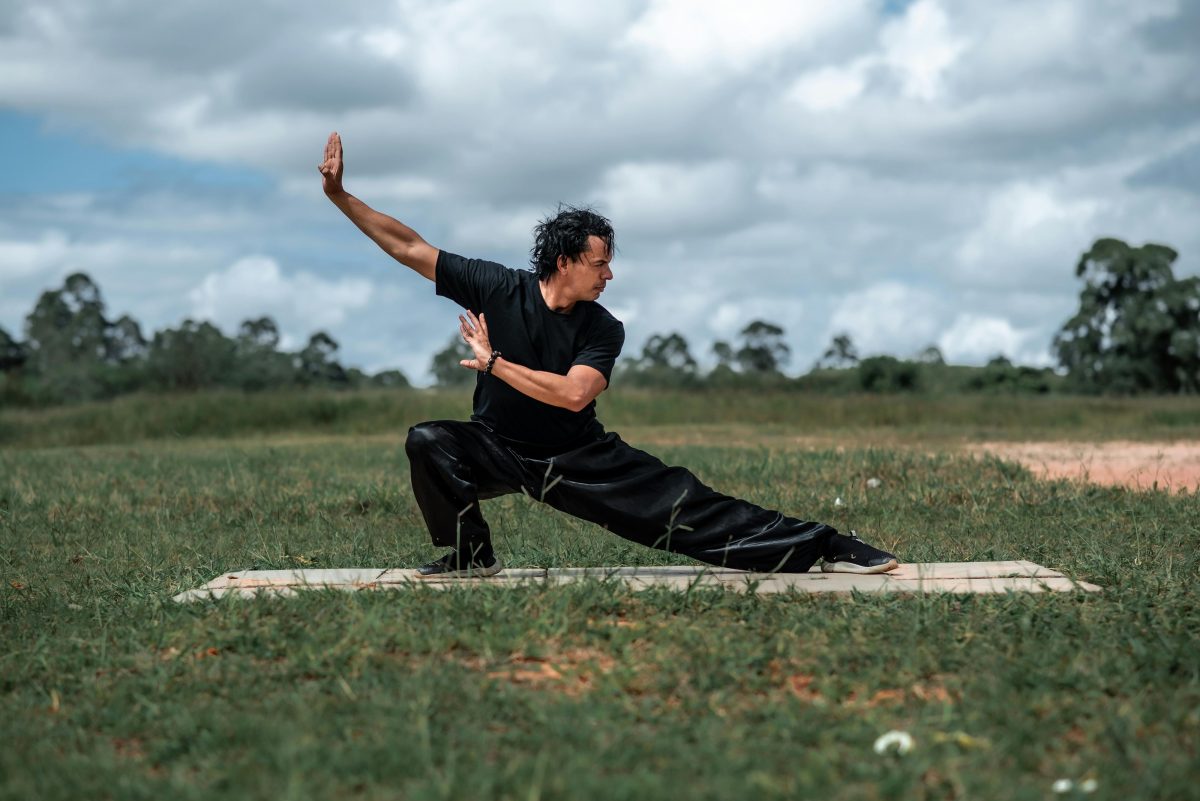Last Updated on: 14th July 2024, 09:29 am
Introduction to Tai Chi

Originating from ancient China, Tai Chi is a practice steeped in history, evolving over centuries from martial arts into a form of movement meditation. This transformation underscores its adaptability and profound impact on physical and mental well-being. Tai Chi, with its gentle, flowing movements, embodies the essence of moving meditation, making it accessible to people of all ages and fitness levels. It’s a holistic approach to health, emphasizing slow, deliberate movements synchronized with deep breathing, fostering a state of calm and clarity.
- The allure of Tai Chi has transcended its Eastern origins, captivating the Western world.
- Its growing popularity in the West can be attributed to its simplicity and the profound benefits it offers.
- Practitioners find themselves immersed in a tranquil flow of movement that not only enhances physical health by improving balance, flexibility, and strength but also promotes mental tranquility, reducing stress and anxiety.
This unique blend of physical exercise and mental focus has positioned Tai Chi as a favored choice for those seeking a serene yet effective path to wellness.
As Tai Chi continues to spread its roots globally, it stands as a testament to the timeless pursuit of harmony between body and mind. Its growing embrace in the West highlights a collective yearning for practices that enrich our lives holistically, making Tai Chi more relevant today than ever before.
The Philosophy Behind Tai Chi

The Principles of Yin and Yang
At the heart of Tai Chi lies the ancient Chinese philosophy of Yin and Yang. This principle embodies the concept of dualism, illustrating how opposite forces are interconnected and interdependent in the natural world. In Tai Chi, this translates to movements that are soft yet strong, promoting balance and fluidity. The practice teaches us that true strength comes from harmony, not force, guiding us to navigate life’s challenges with grace and resilience.
The Concept of Qi (Chi) and Its Significance in Tai Chi
Qi, or Chi, is the life force that flows through all living things, according to Chinese philosophy. In Tai Chi, cultivating and balancing Qi is essential. Through controlled, deliberate movements and deep, rhythmic breathing, practitioners aim to enhance the flow of Qi within the body. This not only boosts physical health but also fosters emotional and spiritual well-being, leading to a vibrant, energized state of existence.
Harmonizing Body, Mind, and Spirit
Tai Chi is more than just physical exercise; it’s a holistic practice that seeks to unify body, mind, and spirit. This integration is achieved through mindfulness, movement, and breath, creating a profound sense of peace and well-being. Practitioners often report a heightened sense of awareness and a deeper connection to themselves and the world around them. By harmonizing these elements, Tai Chi offers a pathway to a more balanced and fulfilling life.
In essence, Tai Chi is a journey of self-discovery and transformation. Its philosophy encourages us to embrace the flow of life, finding strength in softness and power in relaxation. As we move with intention and awareness, we learn to live in harmony with ourselves and our environment, embodying the true spirit of Tai Chi.
Unveiling the Health Benefits of Tai Chi

Physical Health: A Foundation of Strength and Grace
- Flexibility: Improves our ability to perform daily activities with ease.
- Balance: Crucial for reducing the risk of falls and injuries.
- Strength: Promotes a healthier posture and core stability.
Mental Health: The Path to Inner Peace
- Stress Reduction: Calms the mind and eases the body.
- Concentration: Sharpens focus, allowing practitioners to stay present.
- Mood Enhancement: Lifts spirits and combats the blues.
Backed by Science: The Evidence of Well-being
Scientific studies lend weight to the anecdotal evidence of Tai Chi’s health benefits. Research has shown that regular Tai Chi practice leads to significant improvements in balance and motor function, especially in older adults. Studies also highlight its role in reducing stress and anxiety, with measurable decreases in cortisol levels, the body’s stress hormone. Furthermore, Tai Chi has been linked to enhanced immune function and a lower risk of chronic diseases, showcasing its potential as a powerful tool for maintaining health and vitality.
In the realm of health and wellness, Tai Chi emerges as a beacon of holistic healing. Its blend of physical, mental, and emotional benefits, supported by scientific research, makes it a compelling practice for those seeking a balanced and healthy life. As we continue to explore the depths of its potential, Tai Chi stands as a testament to the power of gentle movement and mindful living.
Tai Chi Techniques and Forms

The Importance of Slow, Controlled Movements
At the core of Tai Chi is the principle of moving slowly and with intention. This deliberate pace allows for greater control, enhancing the connection between mind and body. It’s through these slow, controlled movements that practitioners can cultivate balance, strength, and flexibility, turning the body into a vessel of calm and resilience.
Description of Basic Tai Chi Movements for Beginners
- Ward Off: A gentle pushing motion.
- The Crane Spreads Its Wings: Stretches the body.
- Brush Knee and Step Forward: Combines a brush motion with a step.
The Different Styles of Tai Chi and Their Characteristics
- Yang style: Known for its gentle, flowing movements, ideal for beginners.
- Wu style: Focuses on micro-movements, offering a more intimate exploration of balance and precision.
- Chen style: Combines slow movements with sudden bursts of energy, providing a dynamic physical challenge.
- Sun style: Marked by its agile steps, emphasizes fluidity and ease.
Each style of Tai Chi offers a different path to the same destination: a state of physical and mental well-being. Whether you’re drawn to the gentle flow of Yang or the dynamic energy of Chen, the practice of Tai Chi invites you to explore the depths of your own strength and serenity. As you embark on this journey, remember that the true essence of Tai Chi lies not in mastering the most complex movements but in finding harmony within yourself and the world around you.
Practicing Tai Chi: Getting Started

Choosing the Right Style and Instructor
Embarking on your Tai Chi journey begins with selecting a style that resonates with your personal goals and finding an instructor who inspires confidence and connection. Each style, from the gentle flow of Yang to the dynamic Chen, offers unique benefits. A good instructor will guide you through the nuances of movements, ensuring your foundation is solid and your practice, enriching.
Tips for Beginners: Clothing, Equipment, and Setting Realistic Goals
Comfort is key in Tai Chi. Opt for loose, breathable clothing that allows for unrestricted movement. Shoes should provide support without compromising your ability to feel the ground. Minimal equipment is needed, just enough space to move freely. Start with simple goals, focusing on the fluidity of movement and synchronization of breath. Progress naturally, allowing your body and mind to adapt at their own pace.
The Role of Breathing and Mindfulness in Tai Chi Practice
Breathing is the bridge between body and mind in Tai Chi. Deep, rhythmic breaths enhance focus, allowing you to move with intention and grace. Mindfulness, the practice of being present in the moment, transforms your movements into a meditative flow. This conscious connection fosters a deep sense of calm and well-being, making Tai Chi a powerful tool for holistic health.
As you step into the world of Tai Chi, remember that patience and persistence are your allies. With each session, you’ll find yourself moving closer to a state of harmony and balance, embodying the true essence of this ancient practice. Welcome to your Tai Chi journey, a path of discovery, health, and inner peace.
Integrating Tai Chi into Daily Life

Incorporating Tai Chi into Your Daily Routine
- Start your morning with a few minutes of Tai Chi, greeting the day with gentle stretches and flowing movements.
- Find moments throughout the day for Tai Chi, using short breaks to center yourself with deep breathing and a few postures.
- Make Tai Chi a natural part of your daily rhythm, akin to eating or sleeping, through consistent practice.
Tai Chi: A Lifelong Practice
- View Tai Chi as a lifelong companion that grows and evolves with you, rooted in balance and harmony.
- Let Tai Chi guide you through life’s ebbs and flows, serving as a constant source of strength and serenity.
Transformation Through Tai Chi: Personal Stories
- Discover personal transformations through Tai Chi, from relief from chronic pain to a newfound sense of peace.
- Be inspired by others who have embarked on their own Tai Chi journey, witnessing the practice’s transformative power.
Integrating Tai Chi into your life is about weaving a thread of mindfulness and grace into the fabric of your existence. As you continue to practice, the principles of Tai Chi begin to inform your approach to challenges, relationships, and self-care, leading to a more harmonious and balanced life.
In Closing
Tai Chi harmonizes body, mind, and spirit. It’s a journey of self-discovery, resilience, and tranquility. Through its slow, intentional movements, Tai Chi teaches us the power of balance, offering a path to holistic health that enriches our lives at every level. Embracing its principles leads to a profound transformation, where challenges become opportunities for growth, and every movement is a step toward inner peace. Let this ancient practice guide you to a life of harmony and well-being, inviting you to explore its depths and embrace its tranquility in your daily journey.
Tai Chi: Movement Meditation for Health FAQs
Children can practice Tai Chi and benefit from its focus on balance, coordination, and mindfulness. The gentle, playful nature of many Tai Chi movements makes it an appealing and fun activity for children, helping them develop physical skills and concentration in a non-competitive environment. Introducing children to Tai Chi can also foster a lifelong appreciation for exercise, relaxation, and self-awareness.
Tai Chi can be practiced indoors in any spacious and quiet area that allows for free movement. This flexibility makes it an ideal exercise for those with limited outdoor access or who prefer the privacy of their home. Indoor practice can provide a controlled environment, free from distractions and weather concerns, making it easier to focus and relax.
Yes, Tai Chi can help with arthritis by gently exercising the joints without putting them under excessive stress. The slow, flowing movements increase flexibility and strength in muscles around the joints, which can reduce pain and stiffness associated with arthritis. Regular practice can also improve range of motion and enhance overall function.
No special equipment is required to practice Tai Chi, making it an accessible and low-cost option for improving health and well-being. Practitioners typically wear comfortable, loose-fitting clothing and flat-soled shoes to facilitate easy movement and maintain balance. The simplicity of Tai Chi allows individuals to practice virtually anywhere, from parks to living rooms.
Tai Chi improves health by integrating the body and mind through movements that enhance balance, flexibility, and strength without putting too much strain on the body. It encourages relaxation, improves blood circulation, and reduces stress, which in turn can lower blood pressure and improve heart health. The meditative aspect of Tai Chi also contributes to mental health benefits, such as reduced anxiety and depression.
Tai Chi reduces stress by promoting a state of mental calm and clarity through its meditative movements and focus on deep, rhythmic breathing. The practice encourages the release of physical tension and the cultivation of a peaceful, mindful state, which can help lower stress hormones in the body. Regular practice can lead to better stress management and a more relaxed outlook on life.
Benefits from practicing Tai Chi can often be felt within a short period of time, with improvements in mood and stress levels noticeable within weeks. Physical benefits, such as improved balance and flexibility, may take longer to develop, typically a few months of regular practice. Consistency is key to experiencing the full range of Tai Chi’s benefits.
Tai Chi is highly suitable for beginners, regardless of their age or fitness level, because it starts with basic movements that are low impact and easy to follow. Instructors often emphasize personal progress and adapt exercises to meet individual needs, making it accessible to everyone. As skills develop, practitioners can explore more complex forms and techniques.
Tai Chi is a form of martial arts that emphasizes slow, controlled movements and deep breathing to promote physical and mental well-being. It originated in China as a form of self-defense but has evolved into a graceful exercise that can help reduce stress and anxiety. Practitioners of Tai Chi can also experience improved balance, flexibility, and overall health.
Tai Chi and Yoga are both ancient practices that promote health and well-being through movement and breath control, but they originate from different traditions and have distinct practices. Tai Chi is a martial art from China that focuses on slow, flowing movements and is often described as meditation in motion, whereas Yoga, from India, combines postures, breathing exercises, and meditation with the aim of achieving physical and mental balance. While both can improve flexibility, balance, and stress levels, Tai Chi emphasizes continuous movement and martial arts techniques, whereas Yoga includes static poses and a wider variety of spiritual practices.
Orlando is a all round athlete from Australia, now resident in Germany. His sports of passion of American Football(Offensive line), weight training and indoor rock climbing where he uses his 195cm wing span to his advantage.



